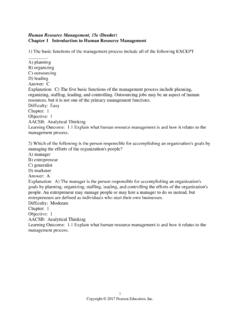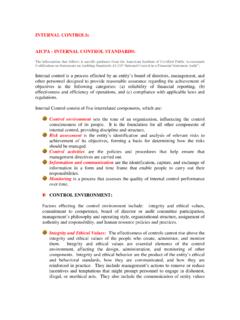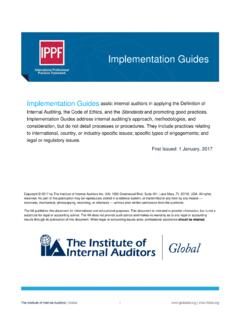Transcription of Business Processes and Business Functions: a new way of ...
1 Monthly Labor Review December 2008 51 Business Processes and Business FunctionsSharon P. BrownBusiness Processes and Business Functions: a new way of looking at employment A new BLS classification system used in conjunction with the Agency s Mass Layoff Statistics program yields fresh information on Business Processes and functions affected by mass layoff eventsSharon P. Brown is Chief, Division of Local Area Unemployment Statistics, Office of Employment and Unemployment Statistics, Bureau of Labor Statistics. E-mail: employers decide to add or eliminate jobs, they are sometimes guided by larger choices to add or eliminate entire classes of activity Business functions within the company. What may appear to be incremental hiring may in fact be the gradual buildup of a new Business function, such as an in-house information technology development department.
2 Or, in-stead, a mass layoff may stem from a decision to outsource a specific Business function, such as human resources management , logistics, janitorial maintenance, or even manufactur-ing. Deciding which Business functions to source to outside vendors and which to per-form in-house is a critical part of corporate strategy, as companies seek to become more efficient and competitive or address changes in demand for outputs or supply of an attempt to shed more light on how workplaces and industries are changing, a classification system has been developed that describes basic Business Processes of the firm and the Business functions that are associated with them. This system is now being used in the Mass Layoff Statistics (MLS) program to identify the functions and Processes involved in job losses from extended mass layoffs.
3 The system, which is now providing new informa-tion on the nature of this type of change in establishments and industries, can be applied equally to other measures of employment, including the current employment structure of a firm, organizational expansions and job growth, and the geographic location of out-sourced work. Called Business Processes and Business Functions, the system is based on an approach that is a synthesis derived from exist-ing literature, models of firms activities, current research on outsourcing and offshoring, the re-sults of a feasibility study of Business functions conducted by the BLS MLS program, and the ongoing collection of the relevant information throughout the Nation by the of work statistics Restructuring and outsourcing of Business functions has long been part of the economic landscape.
4 Companies continually identify strategies to cut costs, become more efficient, expand, and gain access to new markets, among other motivations. As the horizons for moving work have expanded, the offshoring of jobs has become an op-tion that is available to a growing number of employers. Offshoring is often thought to affect only, or at least mainly, manufacturing jobs and production functions. In the early 2000s, however, job losses in information technology and related areas emerged as an important indicator of ongoing change in industries. By 2004, stories on the offshoring of these Business functions and the resultant Business Processes and Busiiness Functions52 Monthly Labor Review December 2008job losses in the United States had become a regular topic of debate in the popular As greater attention was placed on a firm s decision to out-source activities, stories also continued about corporate reor-ganizations and restructurings.
5 These actions were occurring essentially for the same reasons that firms outsource and also involved Processes and functions within the company. Companies were consolidating activities, eliminating layers of management , outsourcing some functions, and expanding others internally, to become more efficient and competitive and thereby improve the corporate bottom order to quantify the anecdotal information on offshoring and outsourcing, the BLS focused on the MLS program, in which monthly and quarterly statistics are collected on plant closings and mass layoffs involving at least 50 workers from businesses employing 50 or A set of questions on the movement of work was added to the MLS employer interview to obtain the following data:Job loss associated with outsourcing. The movement of work to a different company when that work was formerly conducted in-house by employees paid directly by the outsourcing company.
6 The different company can be located inside or outside of the United States. The work may occur at a geographic location different from that of the outsourcing com-pany, or it may remain loss associated with offshoring. The movement of work from within the United States to a location outside of the Nation. Offshoring can occur either within the same company, when it involves the move-ment of work to a different location of that company outside of the United States, or to a different com-pany altogether (called offshoring/outsourcing).Statistics on outsourcing and offshoring have been col-lected by the MLS program since 2004. Job losses associ-ated with the movement of work outside of the United States and that took place for reasons other than seasonal or vacation-related reasons averaged about percent of all private nonfarm separations identified by the MLS pro-gram over the period 2004 07.
7 Contrary to expectations, job losses associated with the movement of work were not concentrated in industries directly connected to computer and electronic products or information. Also, the majority of this layoff activity was associated with domestic reloca-tion of work, mostly within the media reporting on offshoring correctly identified an emerging economic phenomenon, one implication of the MLS statistics on offshoring job losses was that the action involved an activity or function not directly associated with the industry designation of the firm. That is, information technology jobs were being moved out of the country, but from firms with other industry designations. An addition-al impetus for studying Business functions came from the high level of activity in domestic relocations. The single most reported reason for these relocations was reorgani-zation within the company.
8 Despite the details collected on the layoff, the employer interview questions did not reveal what was behind these actions and what, in fact, was the affected part of the traditional classification schemes for identifying in-dustries (the North American Industrial Classification Sys-tem, or NAICS) and for defining occupations (the Standard Occupational Classification system) are not reflective of the full range of activities of the firm. The industry classification approach is based on the primary activity of the establish-ment, as measured by the largest number of jobs performing that activity; other important direct and support activities that operate within the firm are not explicitly recognized. Hence, any change in employment is associated with the industry code determined by the main activity, even if the change in activity has nothing to do with it.
9 Looking at the occupational classification reveals that the problem is that the system defines the firm s workers, but lacks a direct tie to the firm s internal organization and decisionmaking. Thus, both industry and occupation provide a limited picture of the dynamic nature of industrial organization and economic it became clear that companies were using internal organizational schemes in analyzing and implementing employment change that could and did involve any part of the corporate structure, a new classification system reflecting these components was needed in order to better understand the nature of changes in a firm s activitiesAlthough Federal statistical programs have not collected statistics on Business Processes or functions, such data have been used in economic studies and, in recent years, have been mentioned in the popular press in stories on globalization, offshoring, and firm restructuring.
10 Academic economists have described a firm s activities theoretically and used the concept of Business organization in firm and industry stud-ies. Among such approaches is Michael Porter s value chain, which divides a company s technologically and economi-cally distinct activities that it performs to do Business into primary activities and support Similarly, George Monthly Labor Review December 2008 53 Yip has described the impact of global competition and technological improvements on the organization of firm activities and industries, and Timothy Sturgeon and Gary Gereffi, coorganizers of the Global Value Chains Initiative, have contributed to the discussion by identifying and dis-tinguishing between core Business Processes and support activities, using an approach based on the classification scheme developed for the MLS offshoring studies and news accounts focused on activities such as software development and data processing.
















